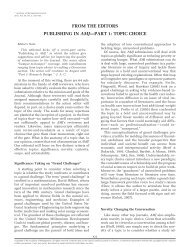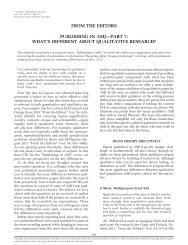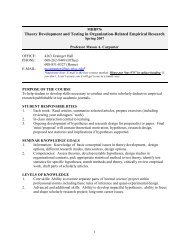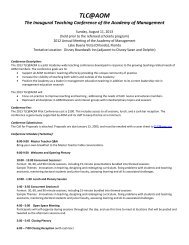inductive reasoning and the creation and justification of new ventures
inductive reasoning and the creation and justification of new ventures
inductive reasoning and the creation and justification of new ventures
You also want an ePaper? Increase the reach of your titles
YUMPU automatically turns print PDFs into web optimized ePapers that Google loves.
550 Academy <strong>of</strong> Management Review<br />
October<br />
dards for this nascent market. Investors had accepted<br />
<strong>the</strong> image early on. Uncertainty about<br />
<strong>the</strong> legitimacy <strong>of</strong> <strong>the</strong> market, however, persisted<br />
in <strong>the</strong> eyes <strong>of</strong> customers; this prompted Secret’s<br />
executives to adjust <strong>the</strong>ir projected identity by<br />
analogically “adding <strong>the</strong> template <strong>of</strong> a ‘public<br />
utility’ that conveyed <strong>the</strong> ubiquity <strong>and</strong> high reliability<br />
<strong>of</strong> a trusted service” (Santos & Eisenhardt,<br />
2009: 650). This adjustment helped <strong>the</strong>m<br />
gain legitimacy for <strong>the</strong>ir venture <strong>and</strong> <strong>the</strong> nascent<br />
market. This elaborated vision also guided<br />
later decisions, such as which activities to pursue<br />
(Santos & Eisenhardt, 2009: 650). In o<strong>the</strong>r<br />
words, as a result <strong>of</strong> interactions with stakeholders,<br />
<strong>the</strong>se kinds <strong>of</strong> adapted images become “social<br />
constructs that guide subsequent actions <strong>of</strong><br />
<strong>the</strong>se entrepreneurs <strong>and</strong> o<strong>the</strong>rs associated with<br />
an industry or market—including customers <strong>and</strong><br />
suppliers” (Alvarez & Barney, 2007: 15).<br />
Replacement refers to <strong>the</strong> substitution <strong>of</strong> <strong>the</strong><br />
initial induced image with an alternative analogy<br />
or metaphor in response to persistent uncertainty<br />
<strong>and</strong> low levels <strong>of</strong> legitimacy in <strong>the</strong> eyes <strong>of</strong><br />
stakeholders. It refers to <strong>the</strong> process where entrepreneurs<br />
substitute, while speaking, <strong>the</strong> initial<br />
image <strong>and</strong> its associated elaborating elements<br />
toward stakeholders with “later verbal<br />
articulations [providing] a framework for developing<br />
shared underst<strong>and</strong>ing” (Hill & Levenhagen,<br />
1995: 1071). Haven, ano<strong>the</strong>r venture studied<br />
by Santos <strong>and</strong> Eisenhardt (2009), is a good example<br />
<strong>of</strong> this process. Haven’s founder had<br />
stumbled upon <strong>the</strong> nascent market <strong>of</strong> online<br />
marketplaces. He personally valued egalitarianism<br />
<strong>and</strong> fused <strong>the</strong>se values into an identity<br />
for <strong>the</strong> venture using <strong>the</strong> metaphorical frame <strong>of</strong><br />
“community,” which led to an emphasis on how<br />
“friends” could connect, share information, <strong>and</strong><br />
trade in a “safe neighborhood” (Santos & Eisenhardt,<br />
2009: 651). Although this identity was clear<br />
<strong>and</strong> understood within Haven itself, <strong>the</strong> team<br />
experienced some difficulties in explaining this<br />
to prospective customers. Thus, it decided to replace<br />
<strong>the</strong> community image with a more factual<br />
account <strong>of</strong> <strong>the</strong> venture’s existence based on a<br />
balanced, fair marketplace for buyers <strong>and</strong> sellers.<br />
This approach failed, however, <strong>and</strong> led to a<br />
return to <strong>the</strong> “community identity,” which was<br />
subsequently emphasized through <strong>the</strong> dissemination<br />
<strong>of</strong> a romantic <strong>and</strong> personal (albeit fictitious)<br />
story about <strong>the</strong> founding <strong>of</strong> <strong>the</strong> venture.<br />
Generally speaking, <strong>the</strong> adaptation <strong>and</strong> replacement<br />
<strong>of</strong> initially induced images for a venture<br />
are done to quell concerns about its predictability<br />
<strong>and</strong> legitimacy (Figure 1). As mentioned,<br />
this adjustment or correction process is likely to<br />
operate as a gradual process (Epley & Gilovich,<br />
2006) in which, based on <strong>the</strong> plausibility <strong>of</strong> <strong>the</strong><br />
initial image for <strong>the</strong> venture <strong>and</strong> <strong>the</strong> ambiguity<br />
in <strong>the</strong> market, an adjustment away from <strong>the</strong><br />
default <strong>inductive</strong> base is made until a satisfactory<br />
solution is reached (Goodman, 1955). Initially,<br />
entrepreneurs are likely to elaborate or<br />
extend <strong>the</strong> induced image by adding fur<strong>the</strong>r<br />
analogies or metaphors. In <strong>the</strong> case <strong>of</strong> Secret,<br />
<strong>the</strong> additional public utility analogy blended<br />
coherently with <strong>the</strong> initial trust image <strong>and</strong><br />
helped communicate <strong>the</strong> predictability <strong>of</strong> <strong>the</strong><br />
venture to customers. These kinds <strong>of</strong> elaborations<br />
or extensions, providing <strong>the</strong>y are coherent<br />
in terms <strong>of</strong> <strong>the</strong> underlying representation, may<br />
help tune communication about <strong>the</strong> feasibility<br />
<strong>of</strong> <strong>the</strong> venture toward specific stakeholders or<br />
audiences. Combinations <strong>of</strong> analogies <strong>and</strong> metaphors<br />
are possible because although exact interpretations<br />
may vary between stakeholders<br />
<strong>and</strong> audiences, <strong>the</strong>ir intuitions about <strong>the</strong> underlying<br />
representation tend to be largely consistent<br />
in terms <strong>of</strong> causes, individual roles, intentionality,<br />
<strong>and</strong> manner <strong>of</strong> actions (Gibbs &<br />
O’Brien, 1990).<br />
Besides addressing <strong>the</strong> uncertainty about a<br />
venture <strong>and</strong> its predictability, an entrepreneur’s<br />
adjustments <strong>of</strong> <strong>the</strong> image for a venture may also<br />
be guided by assessments <strong>of</strong> <strong>the</strong> plausibility <strong>of</strong><br />
<strong>the</strong> analogy or metaphor <strong>and</strong> its ability to confer<br />
legitimacy on <strong>the</strong> <strong>new</strong> venture. Douglas (1986)<br />
famously argued that <strong>new</strong> conventions, such as<br />
claimed <strong>new</strong> markets or <strong>ventures</strong>, gain institutional<br />
legitimacy on <strong>the</strong> back <strong>of</strong> a “naturalizing<br />
analogy”—a drawn parallel or association with<br />
ano<strong>the</strong>r domain that sustains <strong>the</strong> novel convention<br />
by demonstrating its fit with <strong>the</strong> natural<br />
order. In her analysis, when <strong>the</strong> association with<br />
<strong>the</strong> o<strong>the</strong>r domain points to strong parallels with<br />
relations “found in <strong>the</strong> physical world, or in <strong>the</strong><br />
supernatural world, or in eternity, anywhere, so<br />
long as it is not seen as a socially contrived<br />
arrangement” (Douglas, 1986: 48), <strong>the</strong> status <strong>and</strong><br />
taken-for-granted nature <strong>of</strong> this source domain<br />
may by association justify <strong>the</strong> reasonableness<br />
<strong>of</strong> <strong>the</strong> <strong>new</strong> convention.<br />
Recently, Hannan et al. (2007) argued that <strong>the</strong><br />
grounds for legitimacy stem from <strong>the</strong> degree to<br />
which a venture (or indeed any o<strong>the</strong>r organization)<br />
is seen by a stakeholder audience as a










